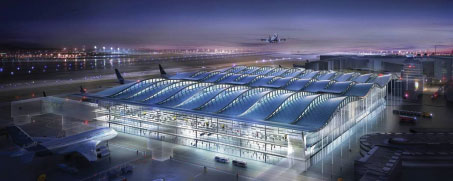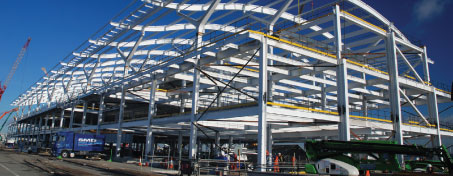
Colin Matthews, BAA chief executive, said: “As we said when the Competition Commission published its provisional findings in August, we do not believe that it has set out compelling evidence to support its view that selling Stansted as well as Gatwick will increase competition and we remain concerned that its proposed remedies may actually delay the introduction of new runway capacity.”
BAA has applied to the Competition Appeal Tribunal (CAT) to the review the final report delivered by the Competition Commission on 19 March, which requires it to sell London Gatwick and London-Stansted airports as well as either Edinburgh or Glasgow airport. Ross Falconer reports.The Competition Commission – the UK’s competition watchdog – has ordered BAA to sell three of its seven UK airports within two years. They are to be sold in sequence beginning with London-Gatwick, for which BAA initiated the sale process in September 2008, followed by London-Stansted and then either Edinburgh or Glasgow. “We have decided that the only way to comprehensively address the detriment to passengers and airlines from the complete absence of competition between BAA’s south-east airports and between Edinburgh and Glasgow is to require BAA to sell both Gatwick and Stansted as well as either Edinburgh or Glasgow. They will each then operate under separate ownership from BAA’s other airports,” said Christopher Clarke, Chairman of the BAA Airports inquiry. “We recognise that in using our powers in this way, we will have a significant impact on BAA’s business. However, given the nature and scale of the competition problems we have found, we do not consider that alternative measures, such as the sale of only one of the London airports or greater regulation, will suffice.”
The Competition Commission also believes strengthening of consultation procedures and provisions on quality of service at London-Heathrow are necessary, until a new regulatory system is introduced. “At Heathrow, the UK’s only hub airport, BAA will continue to have substantial market power even after it no longer owns either Gatwick or Stansted,” said Clarke. “To address the shortcomings in appropriate investment, there is a need for improved consultation between BAA and the airlines, including the provision of necessary information and better processes of consultation. We recognise that there have already been some improvements but there is further to go.”
In a statement, BAA confirmed that it is appealing on two grounds: “The first ground is that the Report is affected by apparent bias. This is because of links between a member of the Competition Commission panel and an organisation interested in acquiring the airports that BAA is required to sell. BAA will also appeal on the grounds that the Competition Commission failed to take into account the adverse financial impact of introducing competition, in particular by requiring BAA to sell three airports within two years in the current financial and economic circumstances.”
These are certainly challenging times in which to sell not one, but three airports. BAA’s UK airports handled 11.5 million passengers in April – a decrease of 2.3% year-on-year. The improvement on the 11.3% decline seen in March was largely due to the timing of Easter, which fell in April this year but in March last year. Combined figures for the two months show a 6.8% fall in passenger numbers, which is consistent with the underlying monthly trend since December 2008.
BAA is seeking an order that the Tribunal quash those findings in the Report requiring the divestiture of Gatwick Airport, Stansted Airport and one of Edinburgh or Glasgow airports and the findings on which that requirement is based; and an order that the Commission pay BAA its costs.
Colin Matthews, BAA chief executive, said: “As we said when the Competition Commission published its provisional findings in August, we do not believe that it has set out compelling evidence to support its view that selling Stansted as well as Gatwick will increase competition and we remain concerned that its proposed remedies may actually delay the introduction of new runway capacity. In Scotland, the Commission has not provided any substantial evidence to support its view that Edinburgh and Glasgow would compete under separate ownership, and we believe there is no justification for specifying which of these airports should be sold.”

BAA initiated the London Gatwick sale process last September. There are three bidders still in the running after Lysander Gatwick Investment – a consortium of Citi Infrastructure Investors, Vancouver Airport Services and John Hancock Life Insurance – was removed from the contest because its bid was too low.
London-Gatwick for sale
Bidders in the Gatwick sale process have made offers between £1.3 billion (€1.5bn) and £1.4 billion (€1.6bn), reportedly well below the level BAA is seeking (thought to be £1.8bn-£2bn), with bidders struggling to raise debt finance from the banks. In May, Lysander Gatwick Investment – a consortium of Citi Infrastructure Investors, Vancouver Airport Services and John Hancock Life Insurance – was removed from the contest because its bid was too low. Meanwhile, the status of the Global Infrastructure Partners bid is unclear; the bidding team stopped work after BAA appealed the Competition Commission order.
In an interesting development, Manchester Airports Group (MAG) – considered the frontrunner in the bidding process – has reportedly discussed teaming up with Global Infrastructure Partners and Lysander. Its consortium includes two other members: Canadian infrastructure investor Borealis and Greater Manchester Pension Fund.
While BAA has been proactive in putting London Gatwick up for sale last September – mere weeks after the Competition Commission’s preliminary findings – it confirmed last month that it is appealing against the order to sell three of its airports. The Competition Appeal Tribunal will hold a case management conference on 1 July.

Terminal 2A (formerly known as Heathrow East) is central to BAA’s capital investment plan, which will see it invest £4.8 billion (€5.5bn) in the period to April 2013. T2A will open in 2014.
Investment continues
In the midst of appealing the ruling on the sale of three of its airports, BAA should be applauded for continuing to press ahead with its capital investment plan, which will see it invest £4.8 billion (€5.5bn) in the period to April 2013. This is vital investment in airport capacity. Central to this is construction of Terminal 2A (formerly known as Heathrow East) and its satellite Terminal 2B, which will replace the existing Terminal 2. The new facility, with a capacity of 30 million passengers a year, will go into operation in early 2014.
“We are progressing with Phase 1 of the Eastern campus. The scheme design is being led by the HETCO (Heathrow East Terminal Company) consortium – a joint venture of Ferrovial and Laing O’Rourke – as well as designers Foster & Partners and Owen Williams. We will then have a design and can prepare for construction,” said Phil Wilbraham, project leader, BAA. “This is all about removing the buildings which are out of date and is part of a strategy to get groups of airlines under one roof. It’s about grouping the Star Alliance carriers in one area at the Eastern end of the campus.”

The structural frame of the Terminal 5C satellite building, which is scheduled to open in 2011, is substantially complete. The €300 million (€345m) facility, as big as the existing Terminal 4 building, will provide a further 12 operational aircraft stands when it opens in 2011.
The key environmental target is to use 40% less power to heat and cool the building than is used in the existing Terminal 2. An Energy Centre will be constructed to enable renewable energy to be used to power the building.







